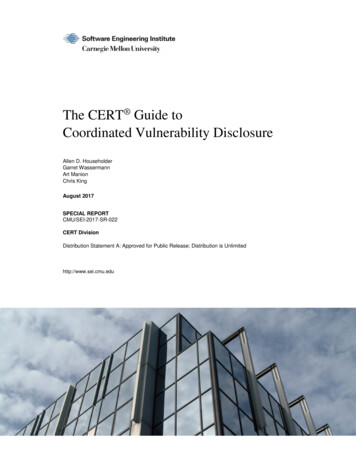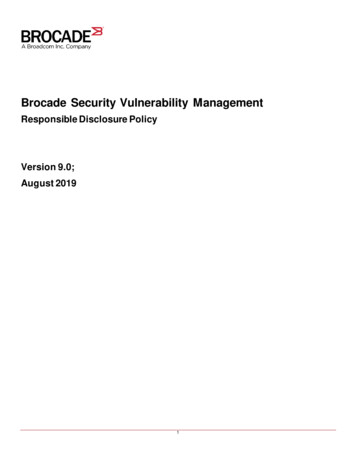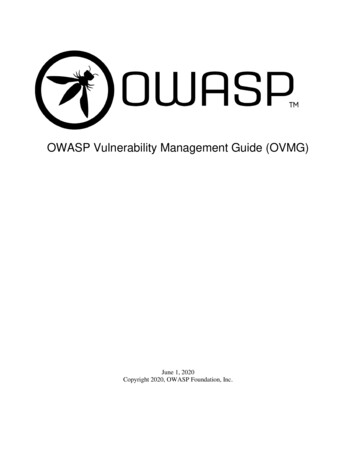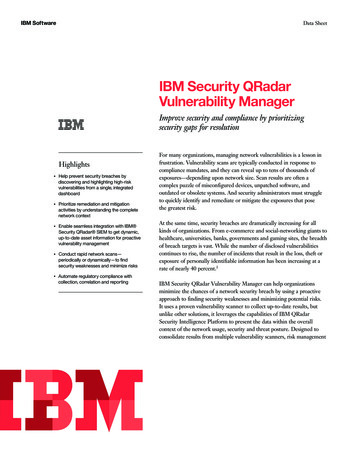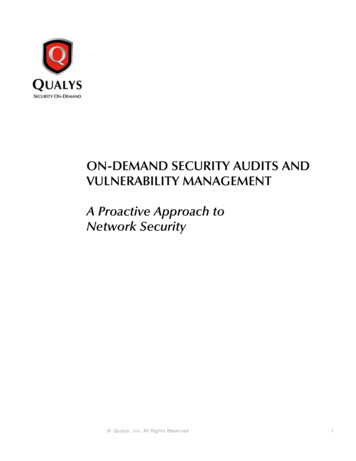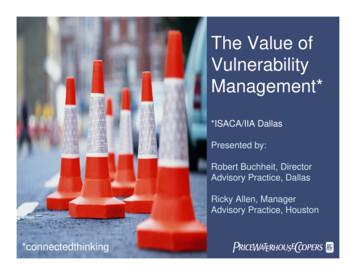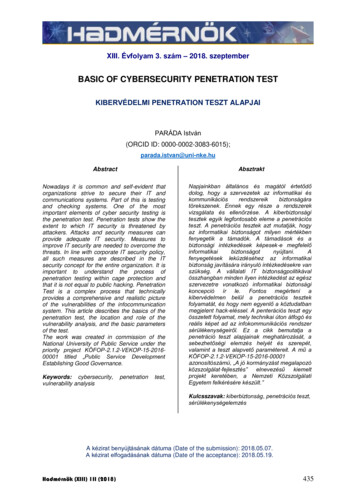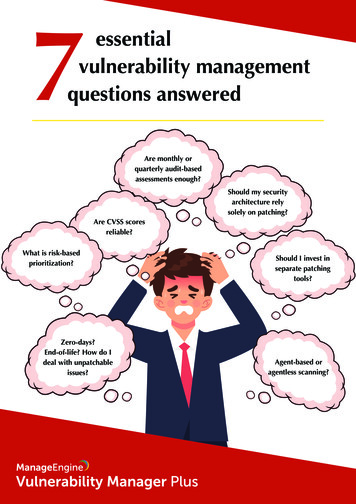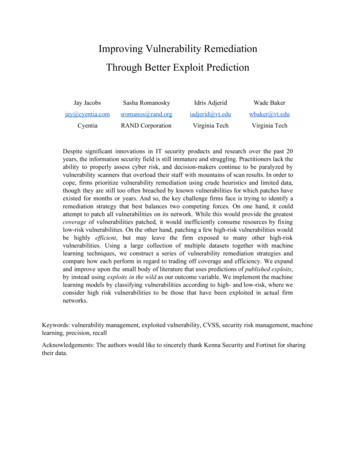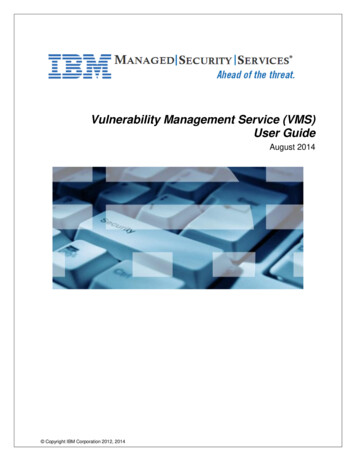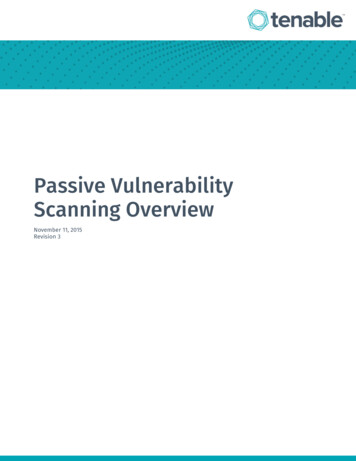
Transcription
[COORDINATED VULNERABILITY DISCLOSURE REPORTING AT ICANN] 1Coordinated Vulnerability Disclosure Reporting at ICANNVersion 2.0Updated 5 August 2013Table of ContentsCoordinated Vulnerability Disclosure Reporting at ICANN . 1Illustration of a Typical Coordinated Disclosure Process .2Commitment . 2Reporting Process: ICANN as Affected Party . 3Notification and Report Submission . 3Confirmation and tracking .4Validation and Status Reporting . 4Resolution and Release. 4Reporting Process: ICANN as Reporter . 5Notification and Report Submission . 5Confirmation and tracking .5Validation and Status Reporting . 5Resolution and Release. 6ICANN as a Vulnerability Coordinator . 7Reference: Other Coordinated Vulnerability Disclosure Policies . 7Emergency Coordination & Crisis Management . 8This document describes the basic principles of Coordinated VulnerabilityDisclosure Reporting as practiced by the Internet Corporation for Assigned Namesand Numbers (ICANN).Coordinated Vulnerability Disclosure refers to a reporting methodology where aparty (“reporter”) privately discloses information relating to a discoveredvulnerability to a product vendor or service provider (“affected party”) and allowsthe affected party time to investigate the claim, and identify and test a remedy orrecourse before coordinating the release of a public disclosure of the vulnerabilitywith the reporter.Coordinated disclosures rely on private communications between reporter andaffected parties during vulnerability investigations to limit risk to or prevent harmto third parties should the vulnerability be made public before remedies can beidentified. Reporters agree to terms of Coordinated Vulnerability Disclosures withthe expectation that the affected parties will seek a remedy when notified. Allparties to the disclosure generally agree to refrain from disclosing the vulnerabilityto the public until a remedy is identified and tested or until the threat is considered1
contained. It should be noted that while reporters and affected parties typicallywork in good faith, a reporter may choose to disclose a vulnerability whenreasonable attempts to coordinate disclosure with an affected party are exhaustedand the reporter is under no (legal) obligation not to disclose.The methodology ICANN describes here for vulnerability reporting also applies toreporting threats to the security, stability, or resiliency of Internet identifiersystems.Under this methodology, a reporter may also give notice of a vulnerability or threatthrough a coordinator who is trusted by all parties to report directly and exclusivelyto the product vendor or services provider, such as a national computer emergencyresponse team (CERT). ICANN explains how it acts as reporter, affected party, orcoordinator.Illustration of a Typical Coordinated Disclosure ProcessFigure 1 illustrates the roles and relationships of parties typically involved in acoordinated irmationUnresponsiveStatus seNotifyPublicUnresponsiveTurn Report over to Coordinator(e.g., CERT)CommitmentICANN is publishing this reporting process within ICANN’s role and remit tofacilitate the security, stability, and resiliency of the Internet’s unique identifiersystems through coordination and collaboration. Visitors and users of ICANNwebsites, systems and services rely on ICANN to protect the data and serviceswithin the systems used by the community and organization. The security of theidentifier systems, data and services is a responsibility ICANN takes seriously.ICANN is committed to protect these from security threats and welcomesresponsible and timely reports of any vulnerabilities discovered on ICANN websites,platforms, or processes. ICANN welcomes responsibly coordinated reports ofvulnerabilities, and ICANN will collaborate with reporting parties to fixvulnerabilities or mitigate threats. Please note however that this document does not2
[COORDINATED VULNERABILITY DISCLOSURE REPORTING AT ICANN] 3give permission to anyone to break any law or to access any non-public data orsystems maintained by ICANN. We expect reporters to abide by the following terms,which we believe are consistent with Coordinated Disclosure Reporting: Reporters will refrain from performing testing against ICANN’s website,platforms, or services that would result in a disruption or denial of service.Reporters agree to privately share details of suspected vulnerabilities to ourwebsite or platforms, or threats to Internet identifier systems.We intend to abide by these same terms when circumstances call for ICANN to serveas a coordinator or reporter.Certain vulnerabilities – for example, where the consequences of an event may(indirectly) affect parties too numerous to contact directly, or where the potentialfor DNS service interruption is imminent or high – may require activation of broadercrisis management handling measures within ICANN (including threat analysis,assessment of the potential for harm and estimation of the targeted assets orpopulations) and in coordination with a wider set of stakeholders (e.g.,international, inter-governmental). This crisis management process is referenced inthis document, but is a separate process, involving coordination with ICANNCommunications and other departments as necessary, depending on the situation.Reporting Process: ICANN as Affected PartyNotification and Report SubmissionReports of vulnerabilities found in ICANN’s websites, platforms, or services, orthreats against identifier systems should be submitted by electronic mail to disclosure@icann.org . For private, secure reporting we recommend that reportersuse PGP or S/MIME. For the latest keys and fingerprints please visithttps://www.icann.org/security/Reporters should include as much of the following documentation as possible in avulnerability or threat report: A summary of the vulnerability or threat,Technical details,Where applicable, a description of how to reproduce the vulnerability,The reporter’s analysis and perceived severity of the vulnerability or threat,andAny additional information that may assist ICANN in investigating the matter.3
ICANN will accept reports if cryptographically protected electronic mail is notavailable to the reporter; in such circumstances, however, the reporter shouldrefrain from submitting vulnerability or threat documentation and instead onlysubmit an email notification to ICANN to determine whether it is necessary toemploy an alternative means to securely transmit technical details or other sensitiveinformation.If you are unable to contact ICANN using electronic mail, please contact us bytelephone at 1 310 301 5800. Indicate that you are calling in regard to an Internetsecurity matter or imminent threats and ask to be connected to ICANN’s incidentresponse officer.Confirmation and trackingICANN will, within one business day, confirm receipt of the notification by email andassign a tracking identifier. Future correspondence between the reporter andICANN, including status reports from ICANN, should reference this identifier.ICANN is a non-profit public benefit organization and is not in a position to offercash awards to reporters, but ICANN would ordinarily be willing to publiclyrecognize and thank any responsible reporters of vulnerabilities or threats.Validation and Status ReportingICANN will investigate the reported vulnerability or threat and provide the reporterwith an initial assessment or estimated time for resolution within two weeks. ICANNwill issue subsequent status reports as it continues to investigate progresses toinform the reporter of changes to the estimated time for resolution, i.e., when itexpects to conclude the investigation, remedy the vulnerability, or report that thethreat is considered contained. ICANN asks that reporters allow for sufficient timeto fully investigate and resolve, especially in circumstances where ICANN has acoordinator role. Vulnerability reporters should refrain from publicly disclosing thevulnerability, threat or methods to reproduce (such as exploit code) while ICANNinvestigates the claim.Resolution and ReleaseICANN will notify the reporter when it has remedied the vulnerability or when itdetermines that the threat is contained. ICANN will have prepared a public releasedescribing the issue and its resolution. We will share this with the reporter so thatthe parties can coordinate the disclosure of the vulnerability, its remedy, or thecontainment of the threat to the public.4
[COORDINATED VULNERABILITY DISCLOSURE REPORTING AT ICANN] 5Reporting Process: ICANN as ReporterNotification and Report SubmissionICANN’s preferred method of reporting vulnerabilities is cryptographicallyprotected email to a designated vulnerability contact published by the affected. In asecure vulnerability notification, ICANN will attempt to provide: A summary of the vulnerability or threat,Technical details,Where applicable, a description of how to reproduce the vulnerability,ICANN’s analysis and perceived severity of the vulnerability or threat, andAny additional information that may assist the affected vendor ininvestigating the matter.Where secure email to a designated contact cannot be identified, ICANN will makereasonable efforts to obtain email or other contact information through other publicresources, such as the administrative contact of the affected party’s domain nameregistration record, social media contacts, alternate channels, or a coordinator suchas a national CERT. In these cases, ICANN will notify the affected party but will waitfor (secure) handling instructions from the affected party before submitting adetailed vulnerability report.Confirmation and trackingDepending on our assessment of the severity of the vulnerability or threat, ICANNwill wait for one to ten days for confirmation of the affected party’s receipt of itsvulnerability notification. Upon confirmation, ICANN will provide documentation (ifnot submitted through a secure notification email), and will refrain from publiclydisclosing the vulnerability, threat or methods to reproduce (such as exploit code)while the affected party investigates the claim.Where the affected party fails to respond after reasonable efforts to contact havebeen exhausted, ICANN will attempt to contact the affected party through otherchannels or coordinators. If all reasonable attempts to contact the affected party fail,or if the vulnerability ICANN has attempted to report becomes publicly known,ICANN will consult with trusted parties such as a national CERT to determine anappropriate and responsible disclosure.Validation and Status ReportingICANN will assist an affected party during its investigation of a reportedvulnerability. We ask that affected parties provide an estimated time for resolutionas well as progress or status reports during the investigation. ICANN will make5
reasonable efforts to assist affected parties with testing to verify a remediation thevendor proposes to release.Resolution and ReleaseAffected parties notified by ICANN of a vulnerability should inform ICANN when thevulnerability is remedied or when it is determined that the threat identified iscontained. Affected parties should try and coordinate any public release describingthe issue and its resolution. Where appropriate, ICANN will make a public disclosurethrough its own communications channels.6
[COORDINATED VULNERABILITY DISCLOSURE REPORTING AT ICANN] 7ICANN as a Vulnerability CoordinatorUnder certain circumstances – particularly where a threat to the security, stability,or resiliency of Internet number systems or global DNS operations is identified –ICANN may be contacted to assist in a vulnerability investigation or threat response.In such circumstances, ICANN will confirm that all parties trust ICANN to act ascoordinator. During this confirmation period, ICANN will (i) facilitatecommunications (i.e., introduce parties, provide vulnerability, abuse, or threatresponse point of contact information) and (ii) privately disclose only suchinformation relating to the threat as is necessary for affected parties to assesswhether they wish to have ICANN coordinate the investigation or response, orwhether the parties will proceed with the investigation or response directly(without ICANN participation).If ICANN is asked to coordinate, we will ask reporters to follow the guidelinesdescribed under Reporting Process: ICANN as Accepting Party. We will assistreporters in determining how to share information and if appropriate, assist inidentifying affected parties (for example, there may be circumstances where ICANNmay be able to identify other parties affected by the vulnerability or threat thanthose identified by the reporter). ICANN will follow the guidelines described underReporting Process: ICANN as Reporting Party, privately share information withaffected parties, and continue to coordinate and support investigation or responseactivities through to and including public release.Reference: Other Coordinated Vulnerability Disclosure PoliciesBelow is a list of disclosure policies ICANN consulted in composing our CoordinatedVulnerability Disclosure Guidelines:CERT/CC Vulnerability Disclosure,http://www.cert.org/kb/vul disclosure.htmlEngineYard Responsible Disclosure e-disclosure-policyGoogle: Rebooting Responsible tmlMicrosoft Security Response Center: Coordinated Vulnerability report/disclosure.aspxSecunia Vulnerability olicy/SoundCloud Responsible tal/articles/439715-responsible-disclosure7
Emergency Coordination & Crisis ManagementIf a vulnerability or event requires activation of broader crisis managementhandling within ICANN and with other stakeholders, ICANN will follow itsemergency coordination and crisis management processes. This is a separate butrelated process from the Coordinated Vulnerability Disclosure.For top-level domain name issues, ICANN has an emergency escalation processdescribed in Specification 10 of the generic top-level domain name RegistryAgreement (see entapproved-02jul13-en.pdf). The process provides for monitoring of TLD registryoperators for service level agreement performance. In the event that emergencyescalation occurs, electronic (email or SMS) and or voice contact notification will besent to the impacted registry operator’s emergency operations department withdetailed information concerning the issue being escalated. If necessary, EmergencyBackend Registry Operators (EBEROs) may be ies/ebero/faqs).For vulnerabilities that ICANN may activate an internal crisis management team,participants from ICANN’s Security, Communications and other departments willconfer and make a determination on whether to trigger the broader crisismanagement process. In the event that this process is activated, it will be managedseparately from the Coordinated Vulnerability Disclosure process outlined in thisdocument.The relationship between the emergency coordination and crisis managementprocess and coordinated vulnerability disclosure process is illustrated in Figure 2:When ICANN receives information or notice of a vulnerability or threat, it willconduct a threat analysis to assess the nature and severity of the threat and willattempt to identify the assets or targets under threat and estimate the impact (and8
[COORDINATED VULNERABILITY DISCLOSURE REPORTING AT ICANN] 9risk) if the threat were to be manifested in a security event. If ICANN determinesthat the threat is real and imminent or severe enough to warrant escalation beyondparties directly affected by a vulnerability (e.g., software vendor or registryoperator that uses the software), ICANN will share its threat assessment withstakeholders ICANN determines are either directly under threat, whose assistance isrequired to mitigate the threat, or whose assistance is required to notify othersdirectly or indirectly under threat; for example, international government agencies,security or engineering communities, or private actors whose awareness orcooperation are needed to respond to the threat (such as an operator of a global andpublic resolver service).Working in cooperation with the notified stakeholders, ICANN would seekconfirmation that its threat assessment is correct. If stakeholders conclude that thethreat is not severe, then ICANN will proceed as a coordinator in its vulnerabilitydisclosure process.If stakeholders concur with ICANN's threat assessment, ICANN and the stakeholderswill determine if the threat warrants immediate disclosure and to whom (e.g., apublic notification). ICANN and the stakeholders will collaborate to investigate,implement a readiness plan (to avert or contain threat not yet materialized), orrespond (mitigate) to a security event.At such time as the threat is averted or contained, or the security event is resolved,ICANN and the stakeholders will determine what notification is necessary. (Note:while not depicted in the flow diagram, ICANN and the stakeholders may choose atany time during their investigation or response to issue notices or progress reports,or they may decide that additional stakeholders should be contacted and asked tocooperate or collaborate.)9
affected parties during vulnerability investigations to limit risk to or prevent harm to third parties should the vulnerability be made public before remedies can be identified. Reporters agree to terms of Coordinated Vulnerability Disclosures with the expectation that the affected parties will seek a remedy when notified. All
